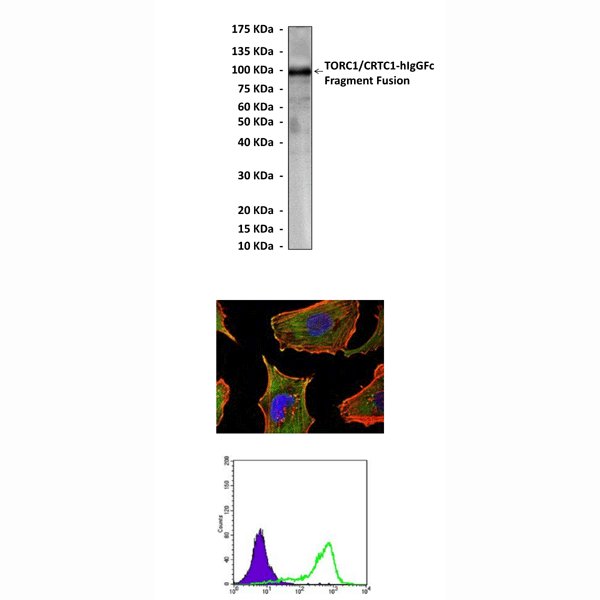Anti-TORC1/CRTC1: Mouse TORC1/CRTC1 Antibody |
 |
BACKGROUND CREB is one of the most well-characterized transcription factors. In response to a variety of stimuli, CREB is activated rapidly through phosphorylation at Ser133 in the kinase inducible domain (KID). In addition, CREB activity can also be regulated through a new family of transcriptional coactivators, termed transducers of regulated CREB activity (TORCs). Three members named TORC1, TORC2, and TORC3 have been found in this family. All three TORCs activate CREB-dependent transcription, but are differentially expressed in different tissues and cells. By contrast with the ubiquitous pattern of TORC2 expression, however, TORC1 mRNA and protein are detected in the brain but not in other peripheral tissues. Sequestered in the cytoplasm through phosphorylation dependent interactions with 14-3-3 proteins, TORCs shuttle to the nucleus following their dephosphorylation in response to cAMP and calcium signals, where they potentiate cellular gene expression by binding to CREB over relevant genes.1 In one model for the regulation of TORC activity, tumor suppressor protein LKB1 can phosphorylate and activate AMPK. The AMPK kinases then phosphorylate TORCs, leading to inhibition of O-glycosylation, binding with 14-3-3 proteins, sequestration in the cytoplasm. It is noteworthy that Ser171-phosphorylated TORC2 retained in the cytoplasm undergoes polyubiquitination at K628 followed by proteosome-dependent degradation. Moreover, it was shown that TORC1 was activated through MEKK1-mediated phosphorylation.2 However TORCs are target of the inhibitory action of dual leucine zipper bearing kinase (DLK) in beta-cells. The DLK-induced inhibition of TORCs. In addition, other secondary messengers such as calcium and cAMP can also regulate TORC activity. While dephosphorylation of TORC2 at Ser171 and Ser275 is induced by a calcium-activated phosphatase known as calcineurin, PKA-mediated phosphorylation of an AMPK-related kinase termed salk-inducible kinase 2 (SIK2) at Ser587, leading to its inhibition and subsequent activation of TORCs. Both TORC and p300 families of transcriptional coactivators are essential for optimal activity of CREB. TORCs and p300/CREB-binding protein (CBP) activate transcription through different mechanisms, but they also synergize with each other.3
The physiological and pathological roles of TORC coactivators have been demonstrated in different contexts.4 First, TORC2 is a key regulator of cell metabolism. It is a sensor of glucose and modulates gluconeogenesis and insulin signaling. TORCs are also transcriptional activators of peroxisome proliferator–activated receptor gamma coactivator 1-alpha (PGC1-alpha), which regulates mitochondrial biogenesis and energy metabolism, and steroidogenic acute regulatory protein (StAR), a mitochondrial protein that transfers cholesterol. In addition, TORC2 coordinates glucose-dependent insulinotropic polypeptide (GIP)-induced expression of antiapoptotic BCL2 gene. Second, TORC2 regulates the normal program of germinal center gene activation and repression to promote B-cell development. Third, TORC1 is required for late-phase long-term synaptic potentiation in the hippocampus. Finally, TORCs are critically involved in tumorigenesis. TORC1-MAML2 is a fusion oncoprotein found in malignant salivary gland tumor and promotes oncogenesis through activating CREB and its target genes. TORCs are also essential coactivator of the Tax oncoprotein of human T-cell leukemia virus type 1 (HTLV-1) in the activation of viral long-terminal repeats, and this coactivation is inhibited by BCL3. Furthermore, it was also shown that TORC1 pathway mediates central effects of hormone and nutrient signals on energy balance and fertility.5 Suffice it to say, TORC coactivators are important regulators of CREB relevant to many biological systems and human diseases.
The physiological and pathological roles of TORC coactivators have been demonstrated in different contexts.4 First, TORC2 is a key regulator of cell metabolism. It is a sensor of glucose and modulates gluconeogenesis and insulin signaling. TORCs are also transcriptional activators of peroxisome proliferator–activated receptor gamma coactivator 1-alpha (PGC1-alpha), which regulates mitochondrial biogenesis and energy metabolism, and steroidogenic acute regulatory protein (StAR), a mitochondrial protein that transfers cholesterol. In addition, TORC2 coordinates glucose-dependent insulinotropic polypeptide (GIP)-induced expression of antiapoptotic BCL2 gene. Second, TORC2 regulates the normal program of germinal center gene activation and repression to promote B-cell development. Third, TORC1 is required for late-phase long-term synaptic potentiation in the hippocampus. Finally, TORCs are critically involved in tumorigenesis. TORC1-MAML2 is a fusion oncoprotein found in malignant salivary gland tumor and promotes oncogenesis through activating CREB and its target genes. TORCs are also essential coactivator of the Tax oncoprotein of human T-cell leukemia virus type 1 (HTLV-1) in the activation of viral long-terminal repeats, and this coactivation is inhibited by BCL3. Furthermore, it was also shown that TORC1 pathway mediates central effects of hormone and nutrient signals on energy balance and fertility.5 Suffice it to say, TORC coactivators are important regulators of CREB relevant to many biological systems and human diseases.
REFERENCES
1. Conkright, M. D. et al: Mol. Cell 12:413-23, 2003
2. Siu, Y-T. et al: Mol. Biol. Cell 19:4750-61, 2008
3. Spencer, R.L. & Weiser, M.J.: Endocrinol. 151:855-8, 2010
4. Conkright, M.D. et al: Mol. Cell 12:413-23, 2003
5. Altarejos, J.Y. et al: Nature Med. 14:1112-7, 2008
2. Siu, Y-T. et al: Mol. Biol. Cell 19:4750-61, 2008
3. Spencer, R.L. & Weiser, M.J.: Endocrinol. 151:855-8, 2010
4. Conkright, M.D. et al: Mol. Cell 12:413-23, 2003
5. Altarejos, J.Y. et al: Nature Med. 14:1112-7, 2008
Products are for research use only. They are not intended for human, animal, or diagnostic applications.
Параметры
Cat.No.: | CP10298 |
Antigen: | Raised against recombinant human TORC1/CRTC1 fragments expressed in E. coli. |
Isotype: | Mouse IgG1 |
Species & predicted species cross- reactivity ( ): | Human, Mouse, Rat |
Applications & Suggested starting dilutions:* | WB 1:1000 IP n/d IHC n/d ICC 1:50 - 1:200 FACS 1:50 - 1:200 |
Predicted Molecular Weight of protein: | 67 kDa |
Specificity/Sensitivity: | Detects endogenous TORC1/CRTC1 proteins without cross-reactivity with other family members. |
Storage: | Store at -20°C, 4°C for frequent use. Avoid repeated freeze-thaw cycles. |
*Optimal working dilutions must be determined by end user.
Документы
Информация представлена исключительно в ознакомительных целях и ни при каких условиях не является публичной офертой








